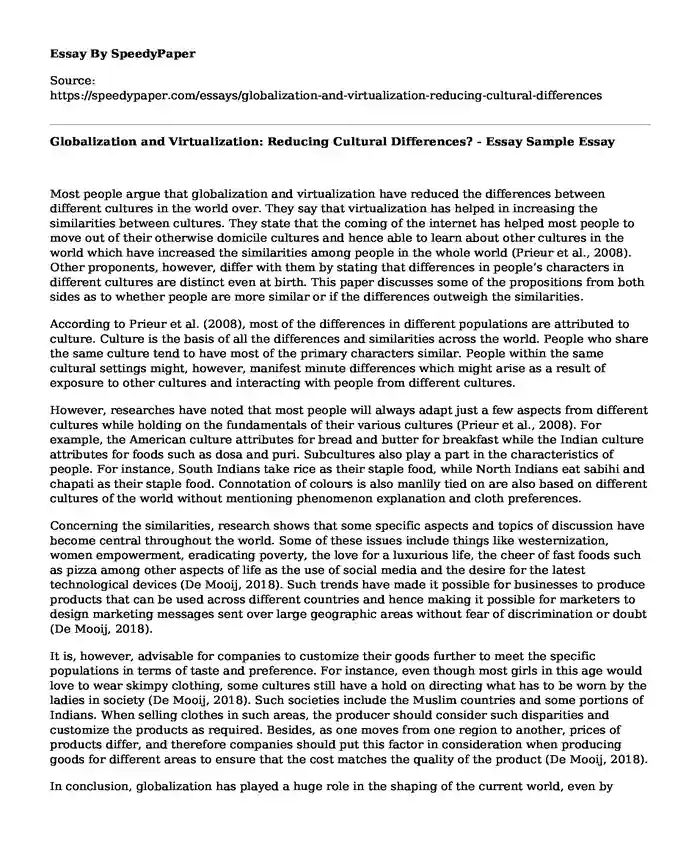
| Type of paper: | Essay |
| Categories: | Globalization Culture Technology World |
| Pages: | 3 |
| Wordcount: | 650 words |
Most people argue that globalization and virtualization have reduced the differences between different cultures in the world over. They say that virtualization has helped in increasing the similarities between cultures. They state that the coming of the internet has helped most people to move out of their otherwise domicile cultures and hence able to learn about other cultures in the world which have increased the similarities among people in the whole world (Prieur et al., 2008). Other proponents, however, differ with them by stating that differences in people’s characters in different cultures are distinct even at birth. This paper discusses some of the propositions from both sides as to whether people are more similar or if the differences outweigh the similarities.
According to Prieur et al. (2008), most of the differences in different populations are attributed to culture. Culture is the basis of all the differences and similarities across the world. People who share the same culture tend to have most of the primary characters similar. People within the same cultural settings might, however, manifest minute differences which might arise as a result of exposure to other cultures and interacting with people from different cultures.
However, researches have noted that most people will always adapt just a few aspects from different cultures while holding on the fundamentals of their various cultures (Prieur et al., 2008). For example, the American culture attributes for bread and butter for breakfast while the Indian culture attributes for foods such as dosa and puri. Subcultures also play a part in the characteristics of people. For instance, South Indians take rice as their staple food, while North Indians eat sabihi and chapati as their staple food. Connotation of colours is also manlily tied on are also based on different cultures of the world without mentioning phenomenon explanation and cloth preferences.
Concerning the similarities, research shows that some specific aspects and topics of discussion have become central throughout the world. Some of these issues include things like westernization, women empowerment, eradicating poverty, the love for a luxurious life, the cheer of fast foods such as pizza among other aspects of life as the use of social media and the desire for the latest technological devices (De Mooij, 2018). Such trends have made it possible for businesses to produce products that can be used across different countries and hence making it possible for marketers to design marketing messages sent over large geographic areas without fear of discrimination or doubt (De Mooij, 2018).
It is, however, advisable for companies to customize their goods further to meet the specific populations in terms of taste and preference. For instance, even though most girls in this age would love to wear skimpy clothing, some cultures still have a hold on directing what has to be worn by the ladies in society (De Mooij, 2018). Such societies include the Muslim countries and some portions of Indians. When selling clothes in such areas, the producer should consider such disparities and customize the products as required. Besides, as one moves from one region to another, prices of products differ, and therefore companies should put this factor in consideration when producing goods for different areas to ensure that the cost matches the quality of the product (De Mooij, 2018).
In conclusion, globalization has played a huge role in the shaping of the current world, even by shaping most of the daily practices and culture. It has led to increased completion among produces, especially to domestic industries. Besides, firms need to keep in mind the cultural differences of different populations for such belief systems still have a hold on today’s practices and belief systems. Therefore, marketing should always be shaped and customized to the intended recipient.
References
De Mooij, M. (2018). Global marketing and advertising: Understanding cultural paradoxes. SAGE Publications Limited.
Prieur, A., Rosenlund, L., & Skjott-Larsen, J. (2008). Cultural capital today: A case study from Denmark. Poetics, 36(1), 45-71.
Cite this page
Globalization and Virtualization: Reducing Cultural Differences? - Essay Sample. (2023, Oct 13). Retrieved from https://speedypaper.net/essays/globalization-and-virtualization-reducing-cultural-differences
Request Removal
If you are the original author of this essay and no longer wish to have it published on the SpeedyPaper website, please click below to request its removal:
- Essay Example: Travel and Tourism Industry Analysis
- The Threat and Opportunity of Cyber Insecurity - Essay Sample
- Essay Example on Preventing System Failures
- Reflection Essay Sample: The Struggle of Latinos in America
- Industrialization of Multinational Enterprises, Essay Sample for Everyone
- Paper Example on Banner Healthcare Case Study
- Unveiling the Masterplan to Derail Iran's Nuclear Program - Free Paper Sample
Popular categories




